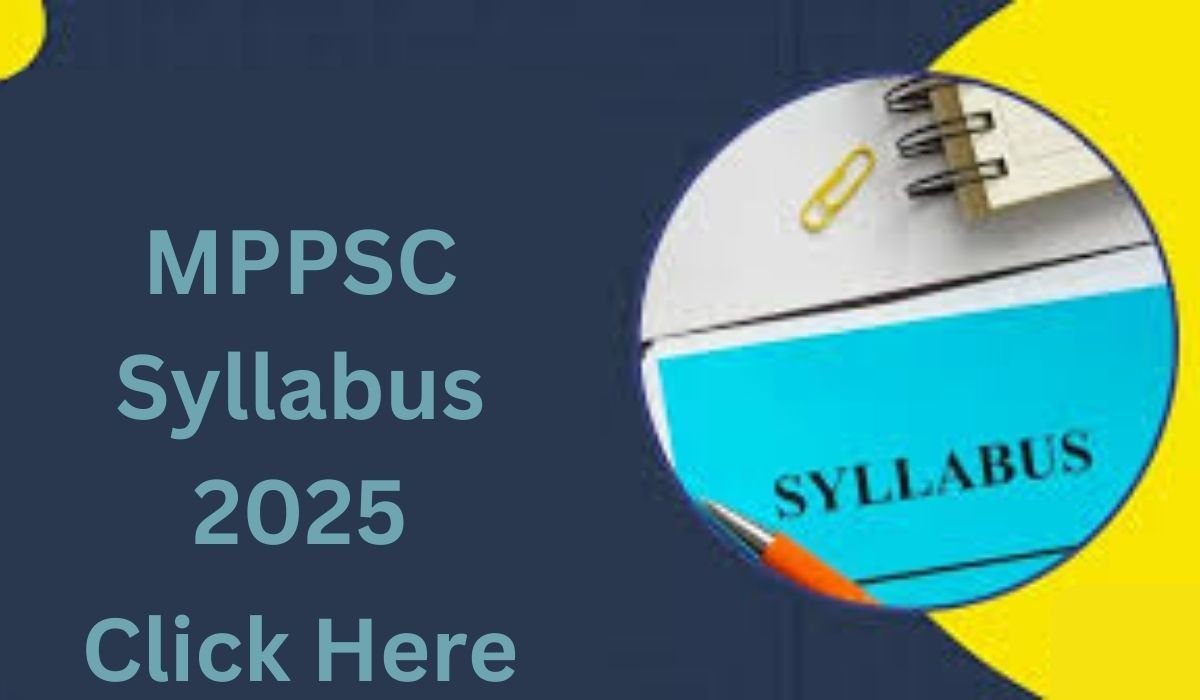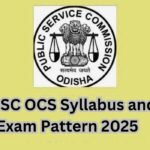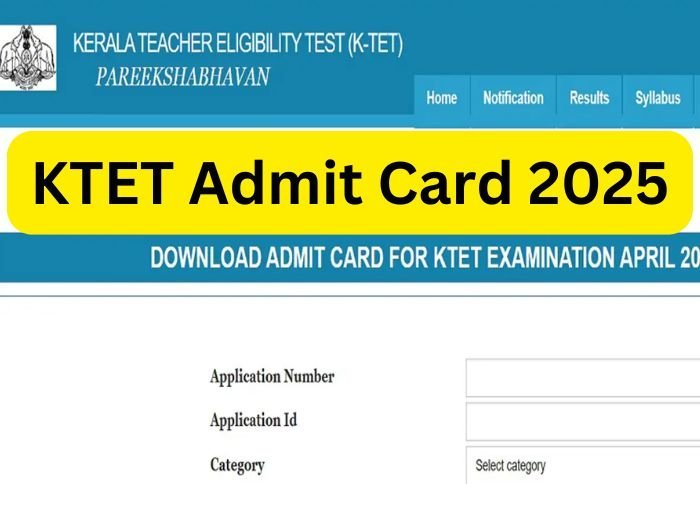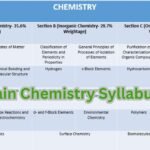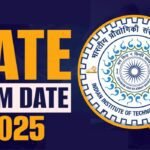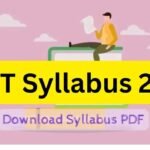MPPSC Syllabus 2025: Madhya Pradesh Public Service Commission has announced the MPPSC Exam Syllabus for the year 2025. The examination is scheduled to take place on 16 February 2025. Candidates aspiring to succeed in this state service examination are encouraged to commence their preparations using the MPPSC exam syllabus for both the preliminary and main stages. The syllabus for the MPPSC Prelims encompasses General Studies and CSAT. It is crucial as it delineates the subjects to be studied, enabling candidates to concentrate their efforts, comprehend the exam format, and effectively manage their time.
MPPSC Syllabus 2025 Highlights
The MPPSC syllabus outlines the topics for both the prelims and mains, assisting candidates in prioritizing essential subjects. An overview of the MPPSC Exam can be found in the accompanying table.

| MPPSC Syllabus 2025 Highlights | |
| Full Form of MPPSC | Madhya Pradesh Public Service Commission |
| Exam Type | State Civil Services Examination |
| MPPSC exam date | 16 February 2025 |
| Mode | Offline |
| Total Duration | 120 Minutes (2 Hours) for each paper |
| Exam Structure | Prelims, Mains, Interview |
| Official Website | https://mppsc.mp.gov.in/ |
MPPSC Exam Pattern 2025
The Madhya Pradesh PSC administers the examination in three phases: preliminary, mains, and interviews. Adhering to this MPPSC exam pattern can significantly improve candidates’ chances of selection. Aspiring individuals should review the MPPSC 2025 Exam details and the MPPSC Previous Year Question Papers.
- Examination Stages: The MPPSC State Service Exam consists of three phases: preliminary examination (objective type, OMR-based), main examination (written descriptive), and interview/personality test.
- Objections and Answer Key: Following the preliminary exam, a provisional answer key will be released. Candidates may submit objections online within 5 days for a fee of ₹150 per question. The final answer key will be published after reviewing the objections.
- Merit List Preparation: The merit list is compiled based on the scores from the written exam and the interview. In the event of a tie, preference will be given to the candidate with the higher written exam score, or if still tied, the older candidate.
The table below offers detailed information.
| MPPSC Exam Pattern 2025 | ||
| Exam Name | Type of the Exam/Duration | Marks |
| MPPSC Prelims Exam | General Aptitude Test Objective (2 Hours)General Studies Objective (2 Hours) | 200200 |
| MPPSC Mains Exam | General Studies I (3 hours)General Studies II (3 hours)General Studies III (3 hours)General Studies IV (3 hours)Hindi (3 Hours)Hindi Essay (2 hours) | 300300300200200100 |
| MPPSC Interview | Personality Test | 185 |
- READ MORE: OPSC ASCO Exam Answer Key 2025 Releasing Soon, check Here for Key PDF and Response Sheets
MPPSC Prelims Syllabus 2025
The MPPSC Prelims Syllabus functions as a preliminary assessment stage, akin to the UPSC Prelims, with the scores from this phase not contributing to the final merit list. The preliminary examination consists of two General Studies papers.
MPPSC Pre Syllabus Paper I – GS
| MPPSC Prelims Syllabus 2025 General Studies Paper I | |
| 1. History, Culture, and Literature of Madhya Pradesh | Major events and major dynasties in the history of Madhya Pradesh.Contribution of Madhya Pradesh to the freedom movement.Major arts and sculpture of Madhya Pradesh.Major tribes and dialects of Madhya PradeshMajor festivals, Folk music, folk arts, and folk literature of Madhya Pradesh.Important Literator of Madhya Pradesh and their literature.Religious and tourist places of Madhya Pradesh.Important Tribal Personalities of Madhya Pradesh |
| 2. History of India | Major features, Events, and administrative, Social, and Economical Systems of Ancient and Medieval India.Social and Religious Reform movements in the 19th and 20th centuries.Independence struggle and the Indian National Movement for Freedom.Integration and Reorganization of India after Independence. |
| 3. Geography of Madhya Pradesh | Physical Geography:- Physical features and Natural regions.Natural Resources:- Forest, Mineral resources, Water, Agriculture, Wildlife, National Parks/ Sanctuaries/Safari.Social Geography:- Population-related Demography (Population growth, Age, Sex ratio, Literacy)Economic Geography: – Natural and Human Resources (Industry, Modes of Transport).Continents/Countries/Oceans/Rivers/Mountains of the world.Natural Resources of the World.Conventional and Nonconventional Energy Resources. |
| 4. Geography of the World and India | Physical Geography:- Physical features and Natural regions.Natural Resources:- Forest, Mineral resources, Water, Agriculture, Wildlife, National Parks/ Sanctuaries/Safari.Social Geography:- Population related Demography (Population growth, Age, Sex ratio, Literacy)Economic Geography: – Natural and Human Resources (Industry, Modes of Transport).Continents/Countries/Oceans/Rivers/Mountains of the world.Natural Resources of the World.Conventional and Nonconventional Energy Resources. |
Syllabus Paper
| 5. ( A) Constitutional System of Madhya Pradesh | Constitutional System of Madhya Pradesh (Governor, Council of Ministers, Legislative Assembly, High Court).The three-tier system of Panchayati Raj and Urban Administration in Madhya Pradesh |
| (B) Economy of Madhya Pradesh | Demography and Census of Madhya Pradesh.Economic Development of Madhya PradeshMajor Industries of Madhya Pradesh.Castes of Madhya Pradesh, Schedule Castes and Scheduled Tribes of Madhya Pradesh, and Major Welfare Schemes of State. |
| 6. Constitution Government and Economy of India | Government India Act 1919 and 1935Constituent Assembly.Union Executive, President, and Parliament.Fundamental Rights and Duties of the Citizens and Directive Principles of State Policy.Constitutional Amendments.Supreme Court and Judicial System.Indian Economy, Industrial Development and Foreign Trade, Import and Export.Financial Institutions- Reserve Bank of India, Nationalised Banks, Security, and Exchange Board of India (SEBI), National Stock Exchange (NSE), Non-Banking Financial Institutions. |
| 7. Science and Technology | Basic Principles of Science.Important Indian Scientific Research Institutions and their Achievements, Satellite and Space Technology.Environment and Biodiversity.Ecological SystemNutrition, Food, and Nutrient.Human Body.Agricultural Product Technology.Food ProcessingHealth Policy and Programmes.Pollution, Natural Disasters, and Management. |
Syllabus Paper
| 8. Current International and National Affairs | Important Personalities and Places.Major EventsImportant Sports Institutes, Sports Competitions, and Awards of India and Madhya Pradesh. |
| 9. Information and Communication Technology | Electronics, Information and Communication TechnologyRobotics, Artificial Intelligence, and Cyber SecurityE-GovernanceInternet and Social Networking SitesE-commerce. |
| 10. National and Regional Constitutional/ Statutory bodies | Election Commission of India.State Election Commission.Union Public Service Commission.Madhya Pradesh Public Service Commission.Comptroller and Auditor General.NITI Aayog.Human Rights Commission.Women Commission.Child Protection Commission.Scheduled Castes and Scheduled Tribes Commission.Backward class Commission.Information Commission.Vigilance Commission.National Green Tribunal.Food Preservation Commission etc. |
MPPSC Pre Syllabus Paper II- General Aptitude Test
The General Aptitude Syllabus of the MPPSC is designed to evaluate candidates’ critical thinking, reasoning, and problem-solving skills. It encompasses a diverse range of topics, integrating both numerical and theoretical elements, which necessitates comprehensive preparation. Below is a summary of the subjects included:
- Comprehension.
- Interpersonal skills, including communication abilities.
- Logical reasoning and analytical skills.
- Decision-making and problem-solving.
- General mental aptitude.
- Basic numeracy.
- Hindi Language Comprehension Skill (Class X level).
Note: Questions about Hindi Language Comprehension Skills at the Class X level will be presented through passages in the Hindi language only, without any English translation provided in the question paper.
MPPSC Syllabus 2025 PDF
The Madhya Pradesh Public Service Commission (MPPSC) has published the MPPSC Syllabus PDF alongside the MPPSC Notification for 2025. This syllabus outlines key topics essential for success in the MPPSC Exam, serving as a detailed guide for candidates. To download the MPPSC syllabus, follow these straightforward steps:
- Visit the official MPPSC website: mppsc.mp.gov.in.
- Navigate to the ‘Syllabus’ section on the homepage or under Exams.
- Select the MPPSC 2024 syllabus PDF.
- Click the link to download and save the document.
To facilitate candidates, we have provided a direct link to download the MPPSC syllabus PDF below.
MPPSC Mains Syllabus 2025
The syllabus for the Main Examination of the Madhya Pradesh Public Service Commission (MPPSC) comprises six descriptive papers that encompass a broad spectrum of subjects. The papers are as follows:
- General Studies Paper 1
- General Studies Paper 2
- General Studies Paper 3
- General Studies Paper 4
- Hindi Essay
- Hindi Language
Candidates seeking to comprehend the subjects and topics included in the MPPSC 2025 Main Exam may consult the detailed table provided below.
General Studies-I
| MPPSC Mains Syllabus 2025 | |
| Exam | Syllabus |
| General Studies-I | Indian History: This covers the history of India from ancient times to the present. It includes important events, rulers, dynasties, and movements that shaped the country. Key areas include the Indus Valley Civilization, the Vedic period, the Maurya and Gupta empires, medieval India, and British colonization. World History: This refers to the study of major global historical events and movements. It includes the rise and fall of empires, revolutions (like the French Revolution), the impact of colonialism, and the development of global systems in politics, economy, and culture. Mughals and their Administration: This topic focuses on the Mughal Empire, which ruled India from the early 16th century to the mid-18th century. It covers the reigns of emperors like Akbar, Jahangir, Shah Jahan, and Aurangzeb, and the administrative systems they put in place, such as taxation, military organization, and governance. Impact of British rule on the Indian Economy: This examines how British colonial rule impacted India’s economy, including changes in agriculture, industry, trade, and the overall economy. British policies like the exploitation of resources, the introduction of new taxes, and trade practices greatly affected India’s economic structure. |
General Studies-I
| General Studies-I | |
| India as a Republic: This refers to the period after India gained independence in 1947 and became a republic in 1950. It involves understanding the establishment of India’s democratic system, the Constitution, and the roles of the President, Parliament, and Prime Minister. Indian Culture, Geography, Water Management, Disaster Management: This section involves: Indian Culture: The rich and diverse culture of India, including its languages, religions, festivals, art forms, and traditions. Geography: India’s physical features like mountains, rivers, forests, and climates, as well as the geopolitical aspects. Water Management: The systems and strategies used to manage water resources in India, including irrigation, river management, and water conservation. Disaster Management: The strategies and systems in place to handle natural disasters like floods, earthquakes, and cyclones, and how to reduce their impact on the population. |
General Studies-II
| General Studies-II | Constitution including Fundamental Rights, Directive Principles of State Policy, Centre, and State Legislatures:Constitution: The Constitution of India is the supreme law that outlines the structure, powers, and duties of the government. It lays down the framework for the functioning of the government at both the central and state levels. Fundamental Rights: These are the basic rights guaranteed to all Indian citizens under Part III of the Constitution. They include rights like the right to equality, freedom of speech, and protection against discrimination. Directive Principles of State Policy: These are guidelines or principles set out in Part IV of the Constitution to help the government frame policies for the welfare of the people, such as promoting social justice and ensuring equal opportunities.Centre and State Legislatures: India has a federal structure with a division of powers between the central government (Union) and state governments. The Centre refers to the national government and the State Legislatures are the legislative bodies of individual states. They are responsible for making laws on different subjects. Social Issues: This refers to challenges faced by society that require attention and solutions. It includes issues like poverty, unemployment, inequality, caste discrimination, gender discrimination, child labour, and more. Addressing these issues is key to improving the quality of life for all citizens. |
General Studies-II
| General Studies-II | |
| Social Sectors including Health, Education, and Empowerment: Health: This refers to the public health system and policies aimed at improving healthcare services, addressing diseases, promoting nutrition, and ensuring access to medical care for all citizens. Education: This includes the efforts and policies aimed at providing quality education at all levels, from primary schools to higher education, and ensuring equal access to education for everyone. Empowerment: Empowerment involves providing people, especially marginalized communities, with the tools, resources, and opportunities to improve their status, rights, and access to decision-making. Education System: The education system in India is structured at various levels: primary, secondary, and higher education. It also includes technical, vocational, and adult education. Policies focus on increasing literacy rates, providing quality education, and reducing educational disparities between urban and rural areas, as well as among different social groups. Human Resource Development: This refers to the development of skills, knowledge, and capabilities of the people in a country to enhance their productivity and contribute to national growth. It includes education, skill development programs, and training initiatives aimed at improving human capital. International Organizations: These are organizations that involve multiple countries working together on global issues. Examples include the United Nations (UN), World Health Organization (WHO), World Trade Organization (WTO), and International Monetary Fund (IMF). These organizations focus on issues like peace, trade, health, and development. |
General Studies-II
| General Studies-II | |
| Public Affairs, Expenditures, and International Organizations: Public Affairs: This refers to the management and communication between the government, the public, and other stakeholders. It includes managing policies, public opinion, and government relations. Expenditures: Government spending, including the allocation of funds for various welfare schemes, infrastructure, defence, education, and health. It also involves managing the financial resources of the state and ensuring efficient use. International Organizations: As mentioned above, these organizations are key to promoting global cooperation and addressing international challenges, such as climate change, human rights, and peacekeeping. |
General Studies-III
| General Studies-III | 1. Science and Technology: Science refers to the study of the natural world based on facts and experimentation. It includes subjects like biology, chemistry, physics, and earth sciences, which help us understand how the world works. Technology refers to the application of scientific knowledge to solve problems and make life easier. This includes innovations in fields like computers, communication, transportation, medicine, and engineering.2. Logical Reasoning: Logical reasoning involves thinking in a structured and logical way to solve problems. It’s about making decisions or drawing conclusions based on given facts, patterns, and evidence. This type of reasoning is often used in exams or competitive tests to evaluate how well someone can analyze and solve problems quickly and accurately. It includes patterns, sequences, puzzles, and other problem-solving activities. |
General Studies-III
| 3. Data Interpretation: Data interpretation is the process of analyzing data (numbers, graphs, charts) to draw meaningful conclusions. In exams, this might involve interpreting data presented in tables or graphs to answer questions. The skill helps you understand trends, compare data, and make decisions based on statistical evidence. 4. Energy and Sustainable Development: Energy: Refers to the resources used to produce power, such as electricity or fuel. This can include renewable energy (solar, wind) and non-renewable energy (coal, oil). Sustainable Development means meeting the needs of the present without compromising the ability of future generations to meet their own needs. This includes using resources wisely, promoting renewable energy, reducing waste, and ensuring environmental conservation to create a balanced, eco-friendly future. 5. Indian Economy: The Indian Economy refers to the economic system of India, including how the country produces goods and services, how money flows in the economy, and how wealth is distributed. Key aspects of the Indian economy include agriculture, industry, services, trade, and the financial system. It also includes government policies on taxation, spending, and economic growth. Understanding the Indian economy involves analyzing issues like inflation, unemployment, GDP growth, and the role of different sectors in the economy. |
General Studies-IV
| General Studies-IV | Social workers/ reformers Aptitude Emotional Intelligence and case studies on various topics such as ethics and integrity |
| For Hindi grammar and Essays check below. | |
MPPSC Syllabus 2025 for Interview
The final merit list will be published by the Madhya Pradesh Public Service Commission, based on the results of the main examination and the interviews.
- The concluding phase of the MPPSC examination is the interview, which evaluates the candidate’s personality.
- This interview segment of the MPPSC State Service Examination is worth a total of 175 marks.
- Given that there is no established syllabus for this phase, candidates are advised to engage in multiple mock interviews with peers and colleagues to enhance their prospects of success.
- The purpose of this stage is to assess the candidate’s competencies and skills.
